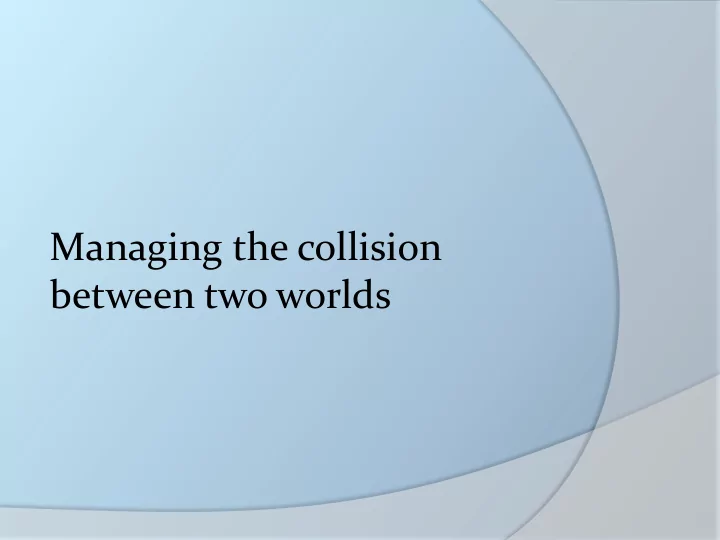

Managing the collision between two worlds
First Law of Aotearoa 1200-1840 Kupe’s laws Adapted to new conditions A system of values and principles for the organisation and administration of kin communities
Whanaungatanga – centrality of kinship and careful attention to relationships Mana – principles of leadership and individual dignity Tapu – behavioural control and sacred/ profane divide Utu – reciprocity obligation Kaitiakitanga – obligation to care for one’s own Flexible and consensus based within a system that naturally defers to mana and collective will
Second Law of New Zealand 1840-1985 Central authority with unrelated officials dispensing its law Individual dignity and autonomy of subjects/ citizens Economic and some social relationships among people defined by contract Relationships with the environment, moveables and (eventually) intangibles defined through concept of property
First and Second Laws collide Treaty is a legal nullity – Māori rights are statutory only; otherwise Crown ‘of necessity is to be the sole arbiter of its own justice’ Native title not justiciable except through statute – recognition conditional on detribalisation of title Recognition of tikanga is temporary expedient on a linear path to extinction and assimilation – NLC applies custom to extinguish it; quasi custom RM courts eventually abolished; autonomous native districts under s 71 Constitution Act never implemented
Whanaungatanga Whanaungatanga rendered redundant as determinant of rights Property rights take over Whanaungatanga removed as a driver of wealth Wage labour takes over Whanaungatanga removed as a mechanism of social control Police and the courts take over
Third Law of Aotearoa-New Zealand 1985-present New legal culture in which tikanga mainstreamed Reinvention of Treaty as creature of law and Treaty settlement process created – Waitangi Tribunal Rediscovery of native title as creature of common law – fisheries , foreshore, rivers and water Reinvention of MLC as a tikanga-perpetuating court in Māori land management – Ture Whenua Maori Act Tikanga law put back into environmental management – Resource Management Act Whanaungatanga returned to Family Law – CYPFA; CoCA
Tikanga law becomes progressively more relevant in mainstream law as the NZ 3 rd law model Criminal justice – sentencing Mental health – assessment and treatment Intellectual property – trademarks and patents Protected objects and cultural treasures Historic places Conservation – access and use of conservation estate – flora and fauna
Hazardous substances and ‘new organisms’ Burials and cremations – Takamore and reform Judicial review – post-settlement iwi exercising public powers
Māori today The general imprisonment rate is 200 per 100,000 The non-Maori rate is 105 per 100,000 The Maori rate is 620 per 100,000 Over 50 % of the general prison population are Maori 60 % of youth in youth justice facilities are Maori 60 % of women in prison are Maori 60 % of CYF removals are Maori
Māori in the criminal justice system Māori are... 3 times more likely to be arrested 3.5 times more likely to be charged 11 times more likely to be remanded in custody 4 times more likely to be convicted 6.5 times more likely to be imprisoned.
There is evidence that Maori are not just more criminal, but more policed and more judged. Age, class and race are the best predictors of prison as a destination.
Yet whanaungatanga still lives…
The Treaty settlement process in New Zealand has been cheap. Even settled tribes lack the resources to remedy these problems yet they are expected to But Treaty settlements have allowed the building of new whanaungatanga infrastructure They just need partnership funding to unleash their own transformative potential Whanaungatanga based solutions are now credible Not everywhere, but in many of the places where answers are most needed
Whanaungatanga must be a central component in any solution because its removal was the central component in the creation of the problem And this must be done through properly constructed partnership models
Recommend
More recommend